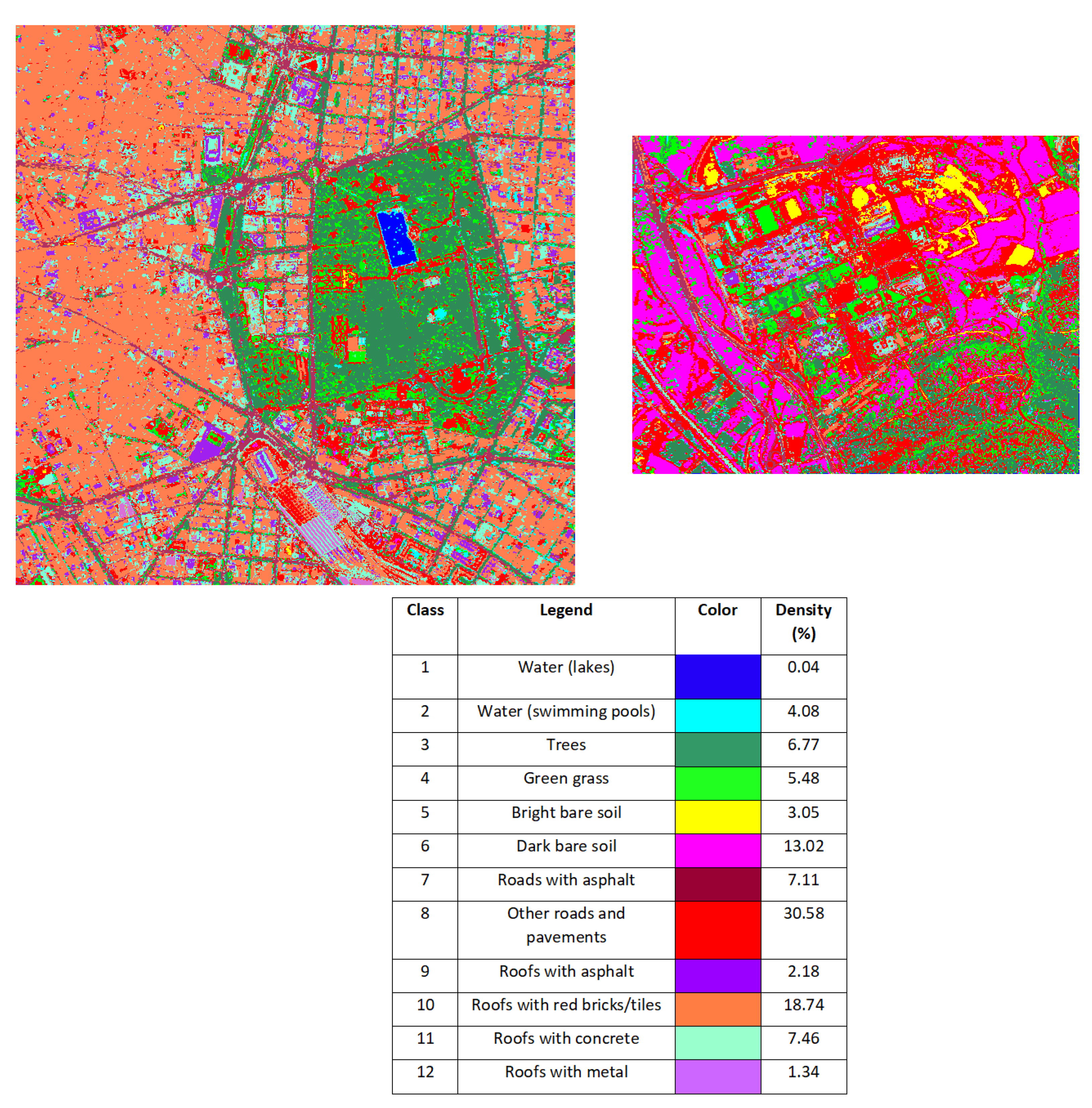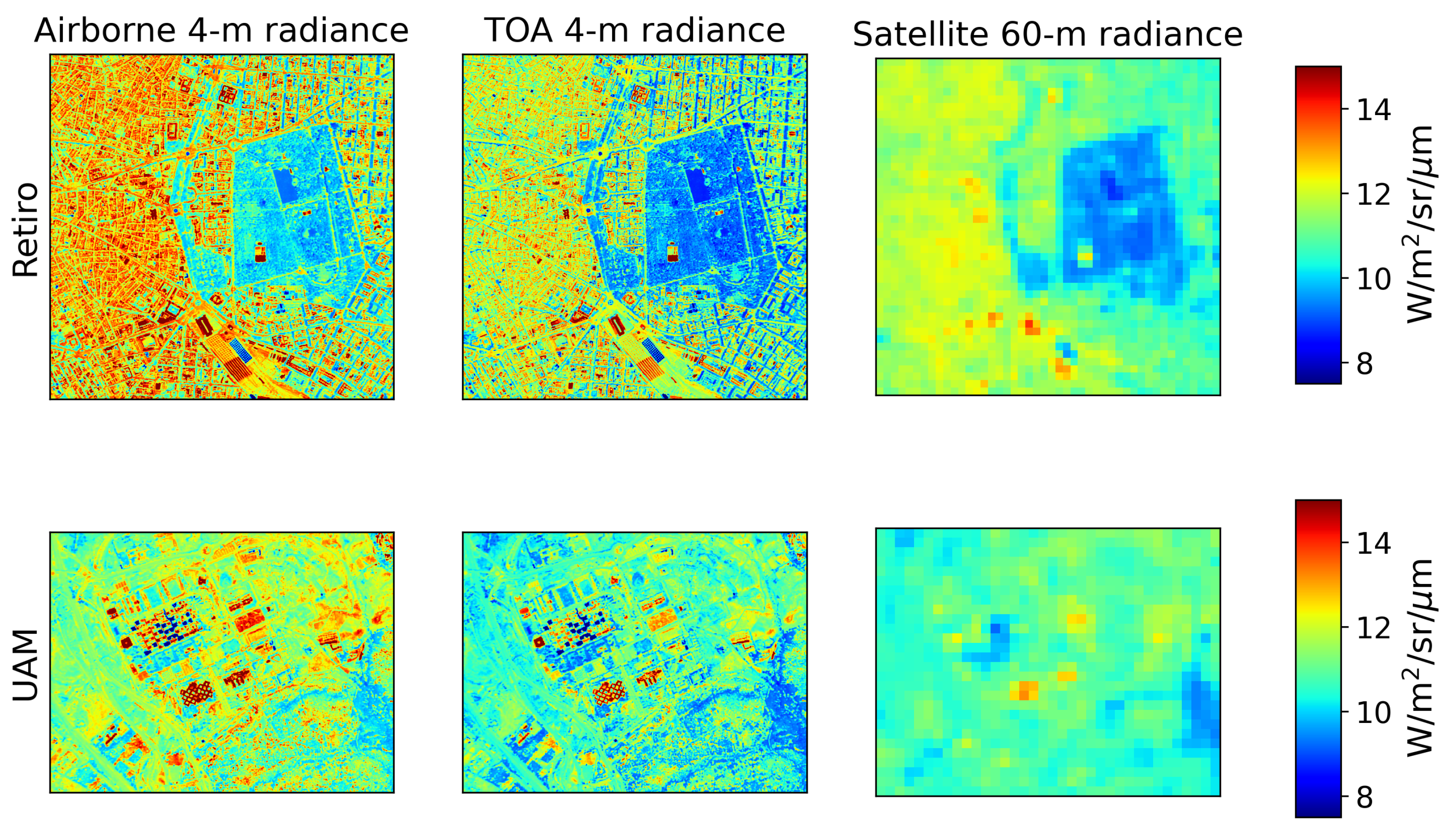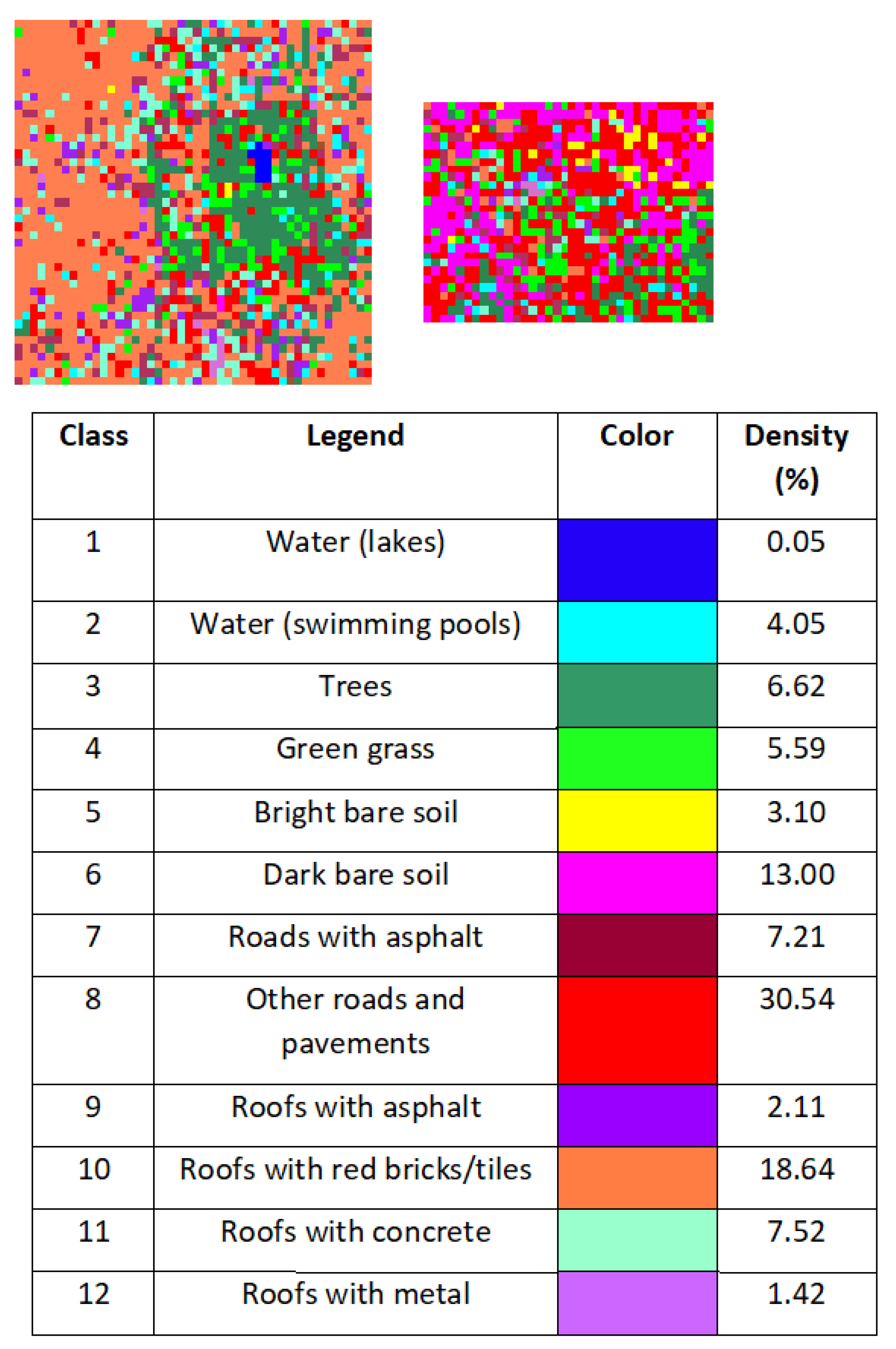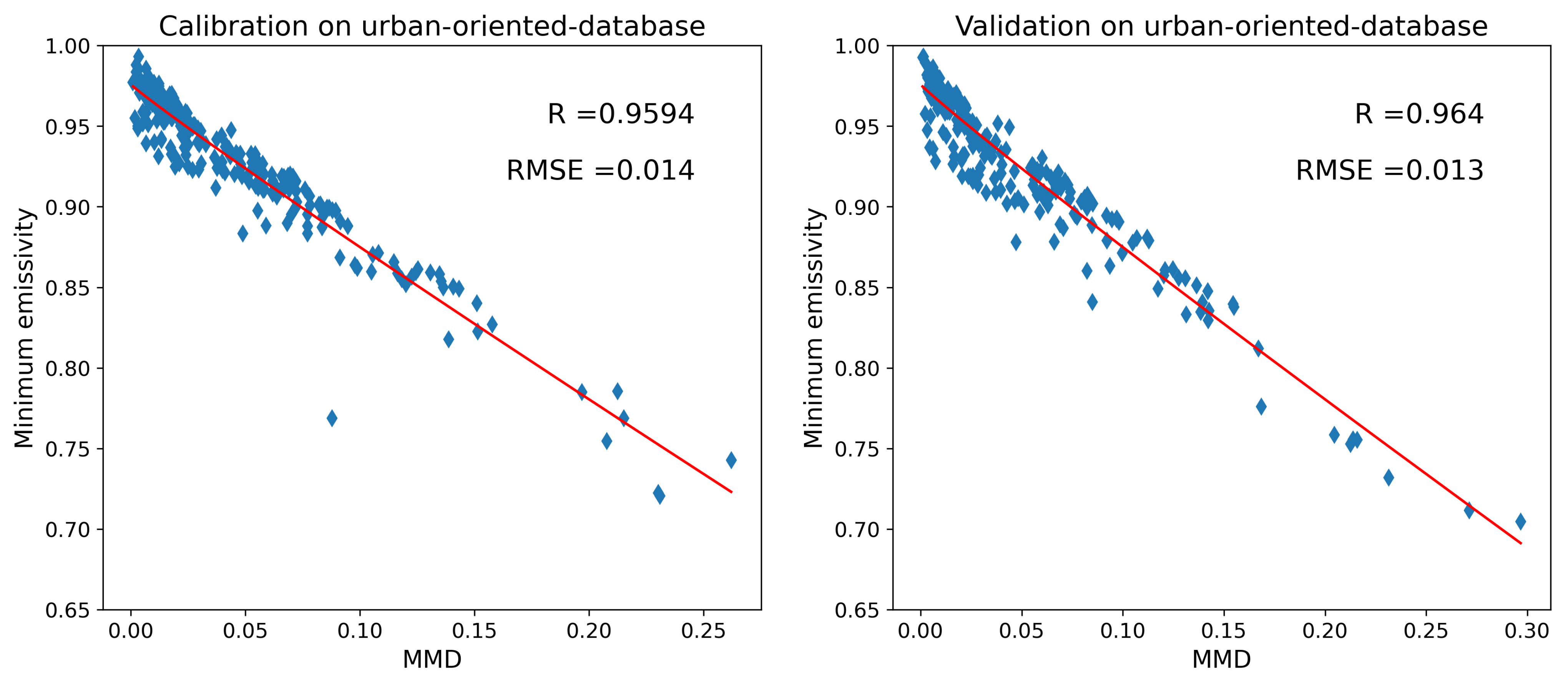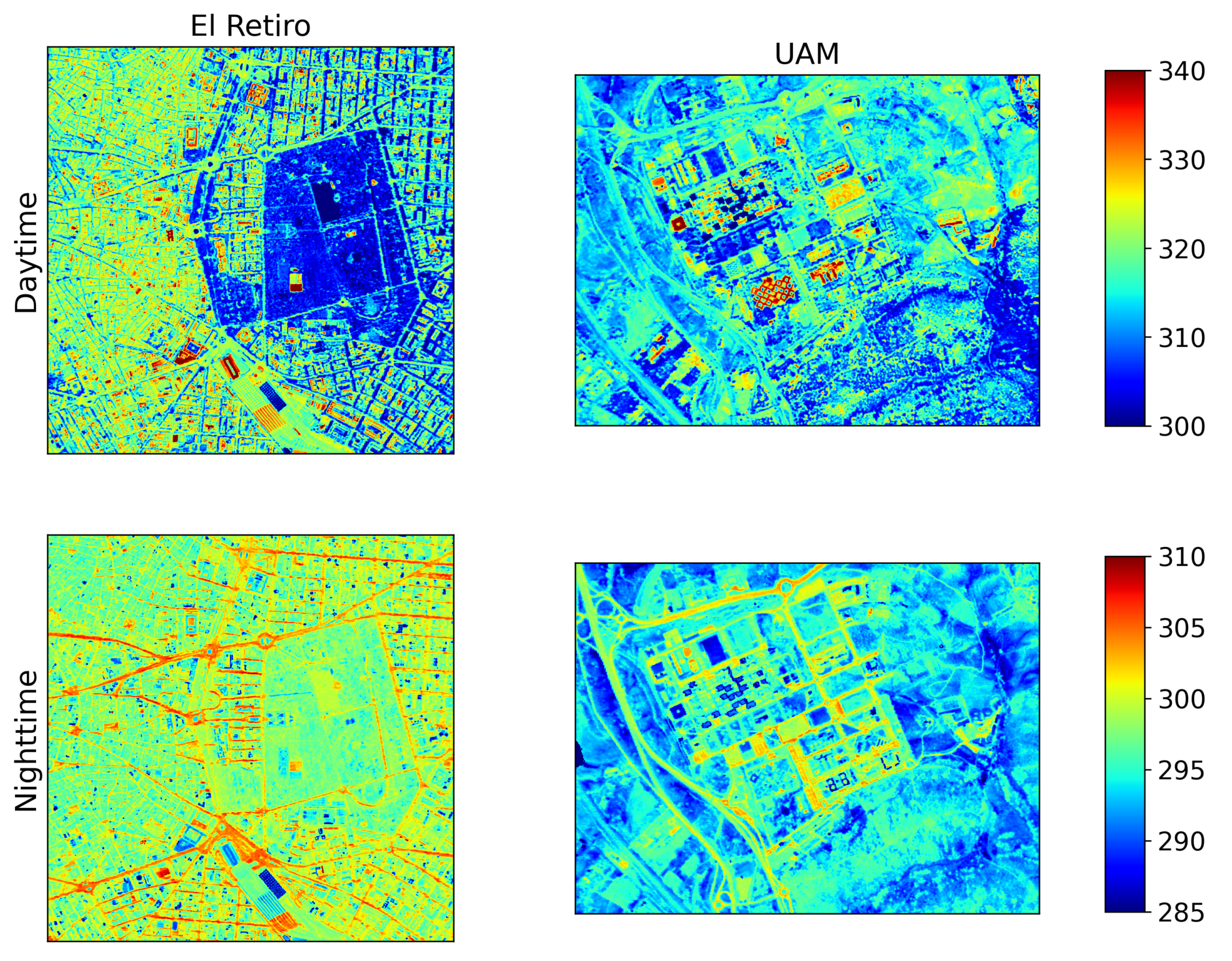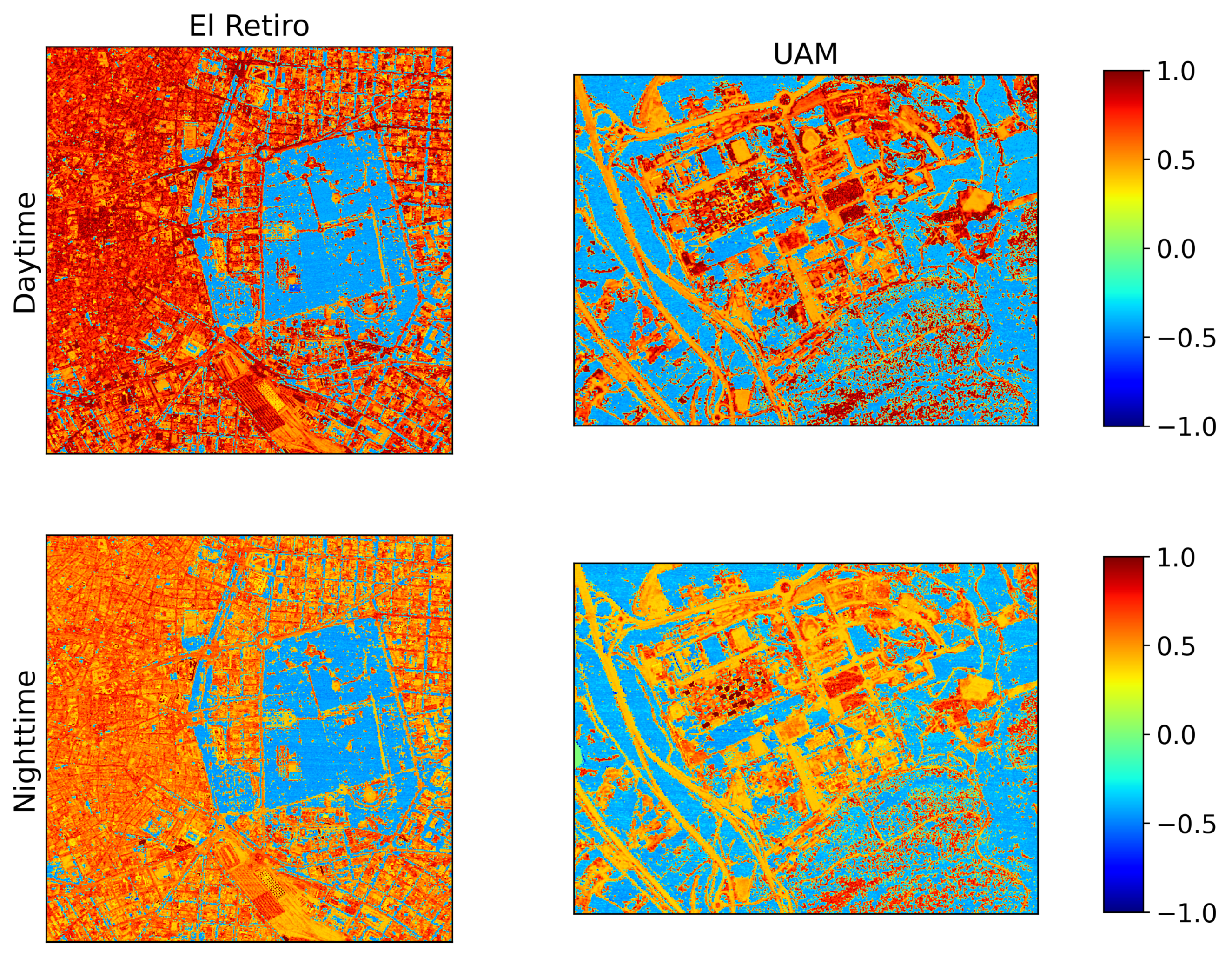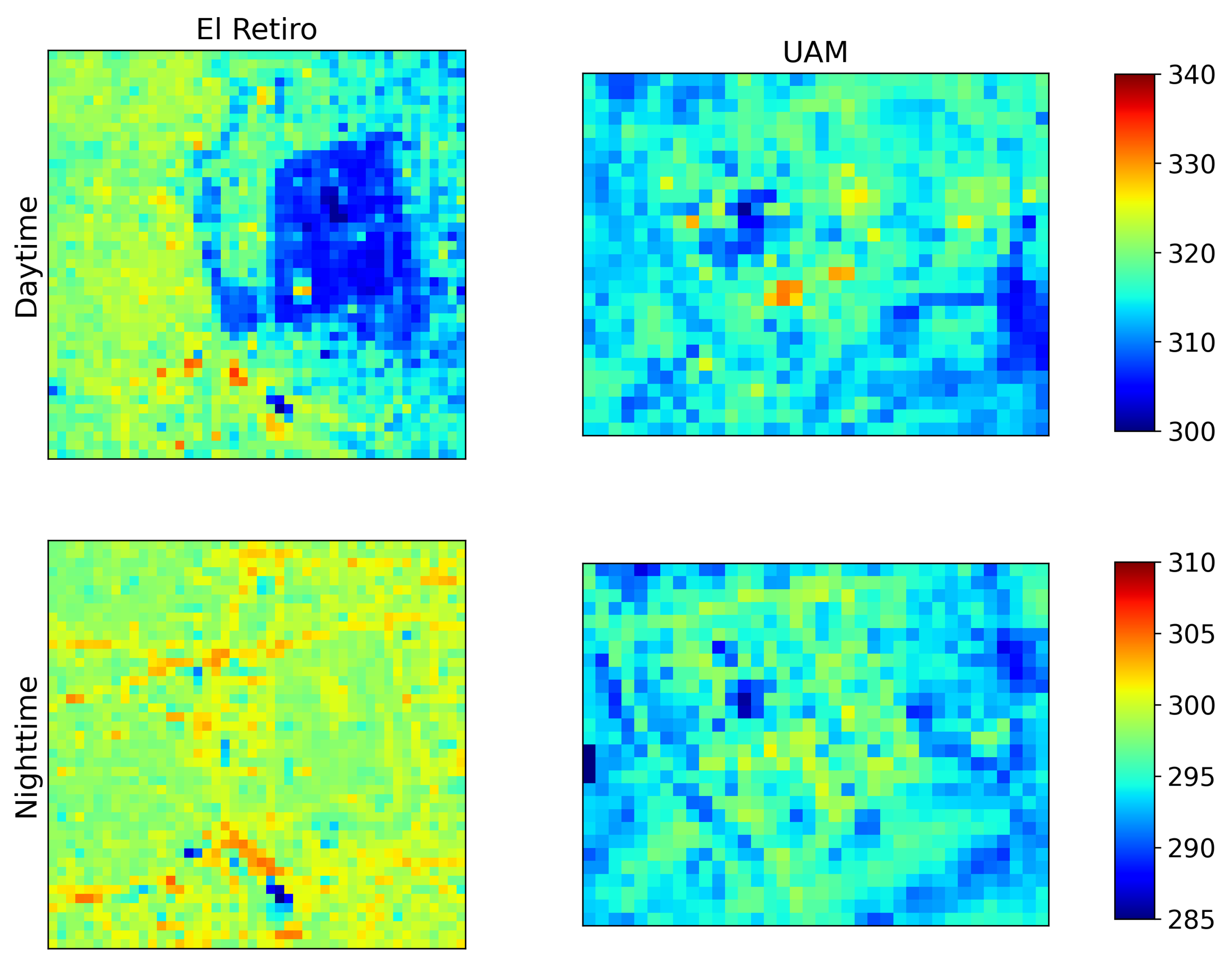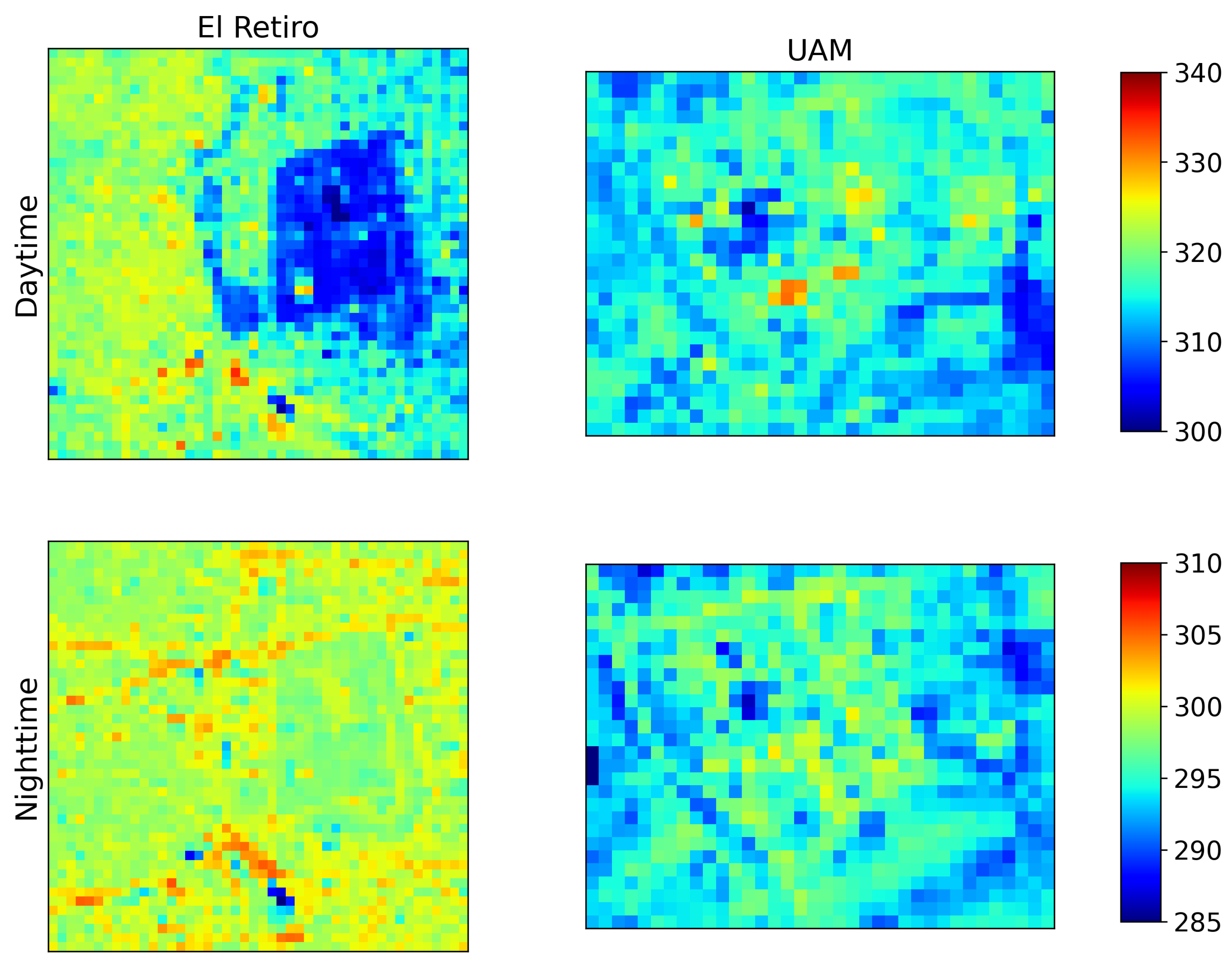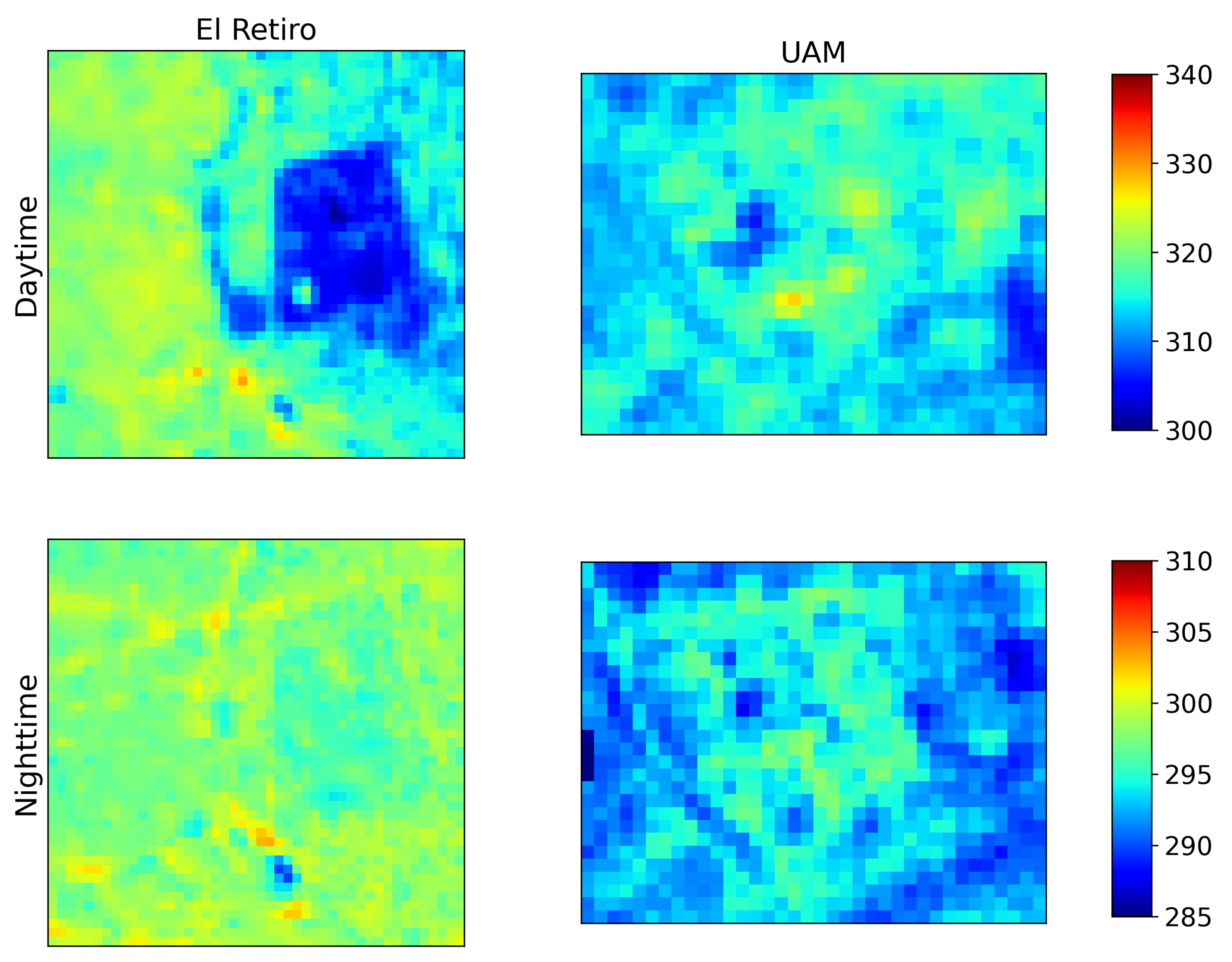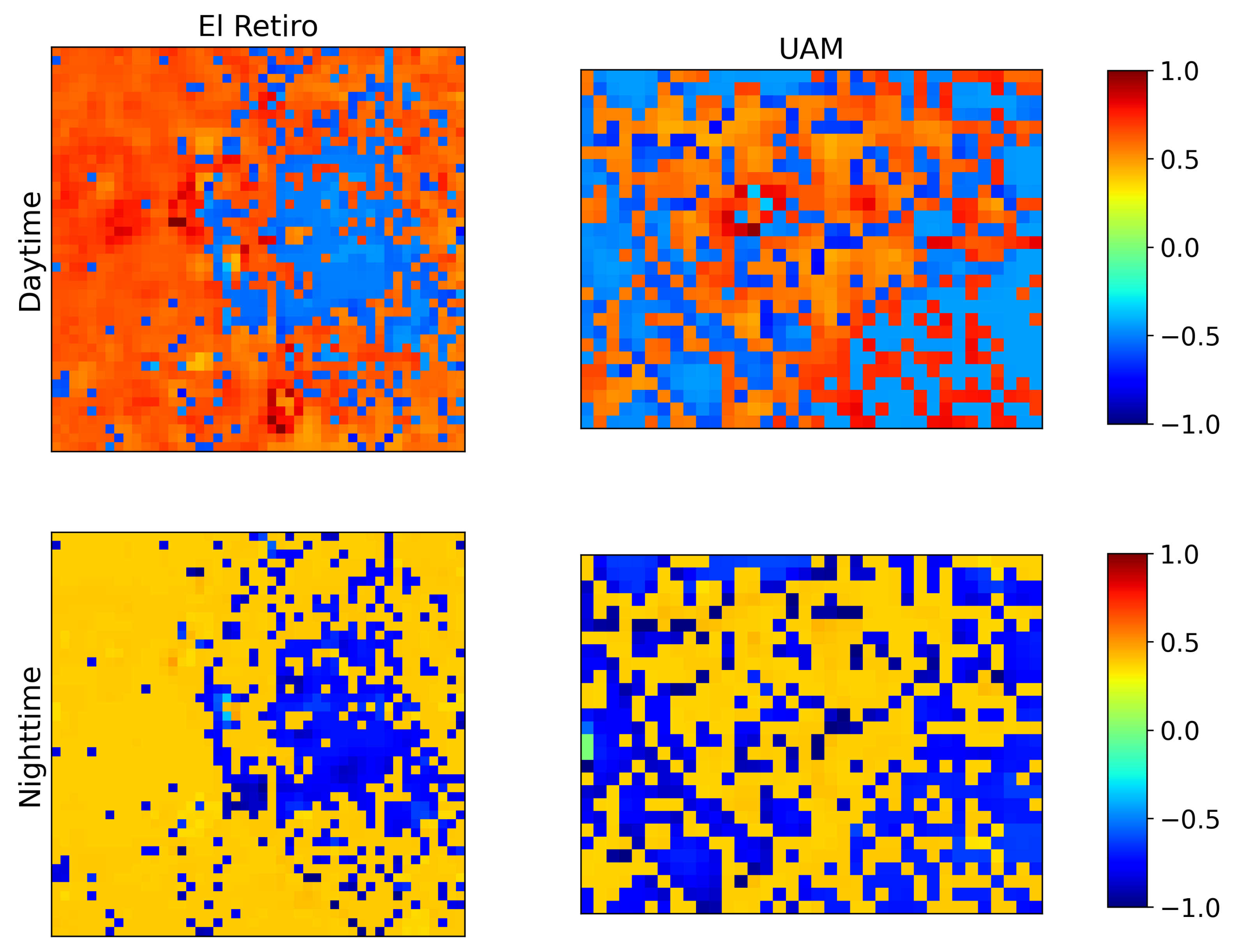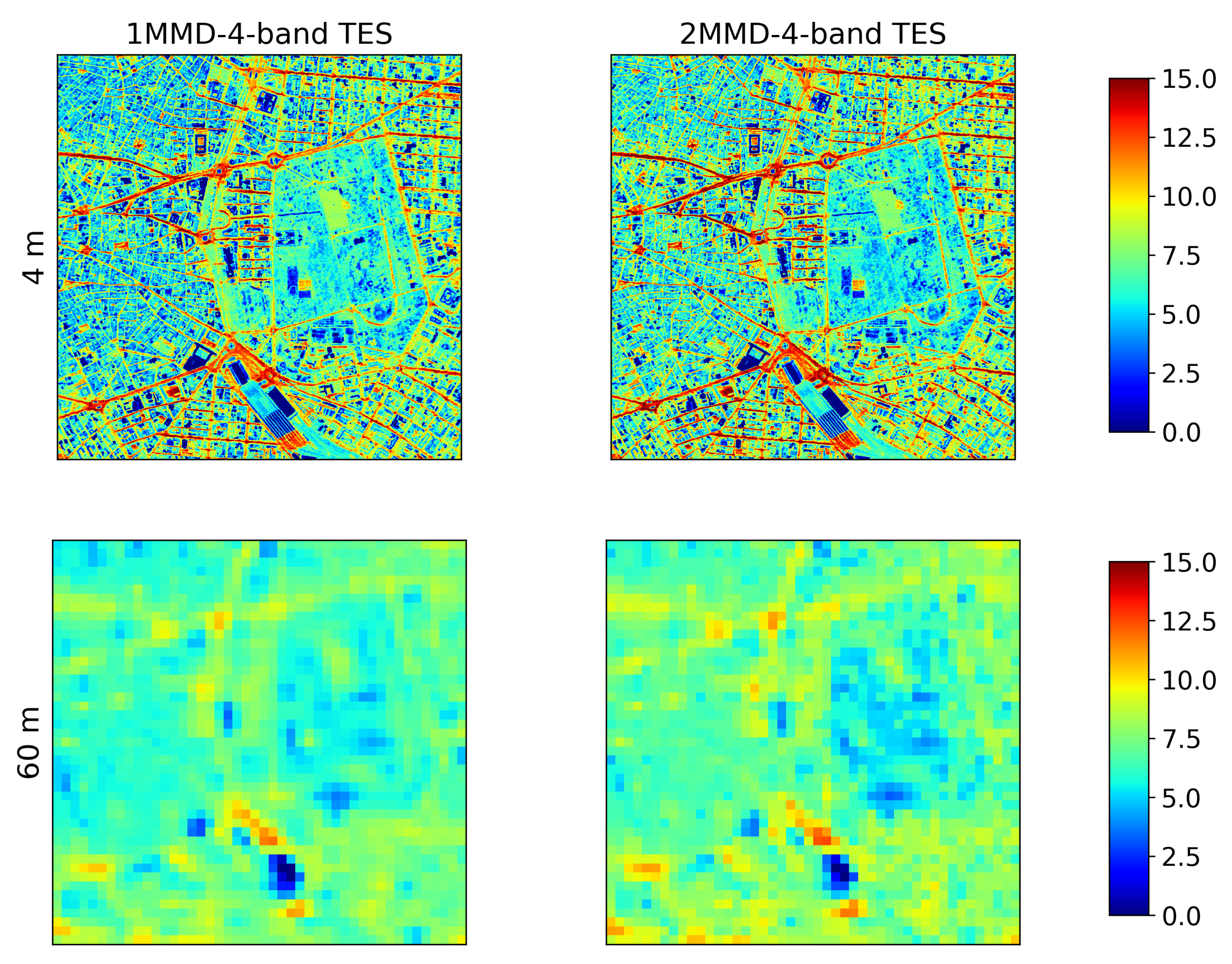1. Introduction
In total, 54% of the world’s population lives in urban areas, and an increase to 66% is expected by 2050 [
1]. Moreover, a recent study highlighted that the mean air temperature rising over urban areas could reach 4.4 K by 2100 [
2]. As such, one-third of the world population will be possibly subject to a higher risk of mortality due to the heat waves, and this amount can increase from 48% to 74% by 2100 [
3]. Actually, this temperature rising is generally due to global warming and is accentuated in cities by the Urban Heat Island (UHI) effect, defined as the difference between the urban and rural (urban surroundings) mean air temperatures. The UHI effect has an impact on air pollution and can lead to sleep disorders or heat stresses for inhabitants, and the air temperature can be used to derive their thermal comfort [
4,
5,
6]. Remote sensing data from the Thermal InfraRed (TIR) spectral domain allows to retrieve the Land Surface Temperatures (LSTs) leading to Surface Urban Heat Island (SUHI) quantifications, considered to be the difference between the mean LST of the central urban area and the mean LST from the surrounding rural area [
7,
8,
9]. SUHI and UHI effects are linked by different thermodynamic phenomena but the LST and the air temperature were found to be coupled during the night, although they are decoupled during the day [
10,
11]. Thus, UHIs can be analyzed with remote sensing data via the quantification of SUHIs because variations of LST and air temperature are correlated together [
10,
12,
13,
14,
15,
16,
17]. The monitoring of SUHIs is also of primary interest in order to enhance the understanding of urban climate and the impact of global warming and urbanization and to help public policies to support climate change mitigation and urban planning activities [
18,
19,
20]. Satellite remote sensing data in the TIR domain provides spatial and temporal variations of the LST at different scales worldwide. Furthermore, LST is also a key parameter to help in the understanding of physical processes other than the UHI effect, such as evapotranspiration, vegetation stress or water cycles [
21,
22,
23,
24].
For these purposes, new generation sensors/satellites such as Thermal infraRed Imaging Satellite for High-resolution Natural resource Assessment (TRISHNA), ESA-LSTM (Land Surface Temperature Monitoring), SBG (Surface Biology and Geology) from NASA or Gaofen-5 in China, all of them carrying onboard multispectral sensors with spatial resolutions under 100-m in the TIR domain, have been conceived. In particular, TRISHNA is an Indo-French joint-mission between CNES and ISRO that will be launched in 2025, following other aborted missions such as Mistigri or Thirsty [
25,
26,
27,
28]. Thus, this mission will be mainly dedicated to the monitoring of agricultural areas, coastal waters and urban areas. A radiometer onboard will cover Visible and Near InfraRed (VNIR), ShortWave InfraRed (SWIR) and TIR ranges with 5 bands in the VNIR-SWIR spectral domain and 4 bands in the TIR one. Moreover, the TRISHNA mission will have daytime and nighttime overpasses with a 3-day repeat cycle and a 60-m spatial resolution, which is better suited for urban studies [
29]. Therefore, TRISHNA and the aforementioned future missions with high spatial resolutions in the TIR domain require the development of adapted LST retrieval methods [
30,
31,
32,
33,
34,
35].
Currently, the Temperature and Emissivity Separation (TES) algorithm is among the most commonly used methods for LST retrieval from remote multispectral data. It presents the advantage of estimating both LST and Land Surface Emissivity (LSE) [
9,
36,
37,
38,
39]. It can be applied with a minimum of three thermal bands so it is adapted to process TRISHNA images. However, TES needs a prior atmospheric correction, and so inaccuracies result in a larger spectral contrast with important effects over gray-body surfaces that have a weak spectral contrast [
40,
41,
42,
43,
44]. Moreover, this algorithm has already been applied to retrieve the LST over urban areas [
45,
46,
47]. Regardless of the aforementioned limitations, the LST retrieval over urban areas is not trivial because of several factors: (i) the strong 3D structure of the urban landscape leads to errors because the geometric effect is not taken into account [
48,
49], (ii) the mean size of urban objects is about ten meters, so the observed pixels from spaceborne sensors are not composed of only one material (mixed pixels), leading to some uncertainties in the retrieved LST [
50,
51,
52], (iii) the adjacency effect [
53], (iv) the anisotropy effect that can appear according to the solar position and the viewing angle [
54], and (v) urban materials exhibit a strong heterogeneity, spectrally, spatially and even temporally, especially artificial materials [
55,
56,
57,
58]. In order to be applied, the TES algorithm needs a prior phase of calibration, achieved with a database of emissivity spectra. Most of the time, the amount of artificial materials in the database is very low, even for urban image processing [
47,
59,
60]. Indeed, the first version of the TES algorithm considered 86 laboratory emissivity spectra of rocks, soils, vegetation, snow and water [
36]. They also tested with other spectra, finding similar results, thus they concluded on the validity of the calibration method. Two main reasons explain why natural surfaces are more commonly used: (i) at the time of the development of the TES algorithm, urban studies were not as developed as nowadays, especially because high-spatial-resolution missions had not been launched yet, and (ii) the artificial materials exhibit a strong spectral heterogeneity, the LSE variability is higher than for natural materials, so the calibration phase can be challenging. Nevertheless, the TES algorithm has been applied over urban areas with knowledge of these limitations. For instance, a 7-band TES used to retrieve the LST over the Madrid urban area was calibrated with 108 natural materials [
10]. Thus, changing the database could avoid inaccuracies of the TES algorithm when dealing with artificial materials.
This article proposes two new versions of the TES algorithm based on two new approaches for the study of urban LST. The calibration of the TES algorithm is based on a non-linear regression of an empirical relationship. The first approach considers the calibration with an urban-oriented database in order to retrieve the parameters of the regression. We call this database urban-oriented because it contains similar amounts of both artificial and natural materials compared with the classical databases based on natural materials only. A unique empirical relationship is defined by this database and we call this approach 1MMD TES. The second approach considers two empirical relationships, one for the artificial materials and the other for the natural ones. The urban-oriented database is split in two for calibration. We call this approach 2MMD TES. An a priori under the form of a ground cover classification map is used to associate one observed pixel to the right empirical relationship.
This article uses airborne images over Madrid (Spain) obtained during the ESA-DESIREX (Dual-use European Security IR Experiment) campaign in 2008. Then, from these airborne acquisitions, TRISHNA images at a lower resolution are simulated. The ESA-DESIREX campaign took place in Madrid during the 2008 summer period, with daytime and nighttime radiance images acquired at a 4-m spatial resolution by the AHS (Airborne Hyperspectral Scanner) sensor and ground measurements. These images have been processed to study the SUHI effect over Madrid city using the TES algorithm with seven bands [
10,
47,
61]. These previous works, the configuration of the AHS sensor (10 spectral bands in the TIR range) and the characteristics of the ESA-DESIREX campaign make the dataset a good candidate to prepare the future TRISHNA mission and the development of adapted LST retrieval methods over urban areas by simulating TRISHNA-like images from AHS data.
This study is among the first ones using TRISHNA-like data over urban areas and aims to obtain preliminary performances of this future mission for LST retrieval. It will help the development of algorithms for the future TRISHNA mission, when a maximum of four spectral thermal bands are used with a 60-m spatial resolution. Thus, the performance of two new versions of the TES algorithm, 1MMD TES calibrated with an urban-oriented database and 2MMD TES, is studied in order to highlight their advantages, their limitations and their possible improvements to enhance the accuracy of the retrieved LST.
The following study is divided into six different sections:
Section 2 presents the materials: the ESA-DESIREX campaign with both airborne and ground data in
Section 2.1, the simulation of TRISHNA-like data in
Section 2.2 and the spectral databases to calibrate the TES algorithm in
Section 2.3. Then, the TES algorithm is presented in
Section 3, focusing on the classical approach in
Section 3.1 and our approach in
Section 3.2.
Section 4 deals with the results, and further discussion is provided in
Section 5. Finally, conclusions and future works are highlighted in
Section 6.
4. Results
The 4 of July 2008 was chosen to show the LST maps provided in this section. Similar visual and quantitative results were found for the other acquisitions. However, the statistical analysis for the comparison of TES LSTs with ground measurements as well as the SUHI values are performed on all the acquisitions.
4.1. LST Map Reference
Figure 9 shows the daytime and nighttime LST reference map in K at 4 m for the 4 of July over the two studied areas (the Retiro Park and the UAM). During the daytime, for both the Retiro Park and the UAM, spatial variations of LST are easily noticeable. For the Retiro Park, the Retiro lake presents the lowest temperature around 300 K, the vegetated area around 310 K, the left part of the Retiro Park is between 300 and 320 K and the right part of the Retiro Park is between 310 and 320 K. For the UAM, the rugby field is between 300 and 310 K, the soccer field around 315 K and some building roofs have high LSTs around 335 K. The surroundings of the UAM have an LST ranging from 300 to 325 K, with the highest LSTs over bare soil waste ground (classified as “dark bare soil”), and the coolest LSTs over vegetated areas (classified as “trees” or “green grass”). The roads have a LST value of around 315 K.
During the nighttime, for the Retiro Park, the water lake does not present LST variations between day and night with LST ≈ 300 K in agreement with the heat capacity of water. The streets have the highest LSTs around 305 K, and some other roads have a LST value of around 302 K. The vegetated area of the Retiro Park is around 298 K. However, for both daytime and nighttime, some unusual patterns can be seen with low LSTs, especially on one roof of the Atocha train station. For the UAM, unusual patterns can be seen in the center of the image within the campus with low LSTs under 285 K. Otherwise, the streets have the highest LSTs around 302 K and surroundings have an LST value ranging from 285 to 297 K. It is worth noting that the observed unusual patterns are seen during daytime and during nighttime. This observation is discussed in
Section 5.1.
Table 4 gives the mean and the standard deviation of the LST. Between the Retiro Park and the UAM, the mean LST difference is 1.6 K and the std difference is 2.3 K for daytime. The mean LST difference is 4.4 K for nighttime and the std values are the same. Between daytime and nighttime, the mean LST difference is 17.3 K for the Retiro Park and 20.1 K for the UAM. The std difference is 5.5 K for the Retiro Park and 3.2 K for the UAM.
4.2. LST Retrieval with the 1MMD-4-Band TES and the 2MMD-4-Band TES with TRISHNA-like Spectral Configuration at 4 m
Figure 10 and
Figure 11 show the daytime and nighttime LST in K for both studied areas as retrieved with the 1MMD-4-band TES and 2MMD-4-band TES, respectively. For a statistical analysis of performances,
Table 5 shows the RMSE, MBE and SSIM between the 1MMD-7-band TES from [
10,
59,
78] and the 1MMD-4-band TES and the 2MMD-4-band TES of this study. This table also shows the mean and standard deviation of the LSTs obtained with the 1MMD-4-band TES and the 2MMD-4-band TES.
During both daytime and nighttime and for both the Retiro Park and the UAM, the obtained LST maps are similar to the LST map reference, see
Figure 9,
Figure 10 and
Figure 11. Thus, the same observations can be made.
Looking at the mean and standard deviation of the LST in
Table 5, for the 1MMD-4-band TES, the mean LST difference is 1.8 K and the std difference is 2.5 K for the daytime between the Retiro Park and the UAM. The mean LST difference is 4.5 K and the std difference is 0.4 K for nighttime. For the 2MMD-4-band TES, the mean LST difference is also 1.8 K and the std difference is 2.4 K for daytime between the Retiro Park and the UAM. The mean LST difference is 4.6 K for nighttime, and the std difference is 0.1 K.
Between daytime and nighttime, for the 1MMD-4-band TES, the mean LST difference is 17.7 K for the Retiro Park and 20.5 K for the UAM. The std difference is 5 K for the Retiro Park and 2.9 K for the UAM. For the 2MMD-4-band TES and between daytime and nighttime, the mean LST difference is 17.7 K for the Retiro Park and 20.5 K for the UAM, just like the 1MMD-4-band TES. The std difference is 5.1 K for the Retiro Park and 2.8 K for the UAM.
These differences are similar for all TES algorithms, meaning that there is a physical coherence between the three versions. Considering the comparison with the LST map reference, during the daytime, the RMSE values are lower for the 2MMD-4-band TES than for the 1MMD-4-band TES of 0.22 K for the Retiro Park and 0.06 K for the UAM, meaning that there are larger discrepancies between the 1MMD-4-band TES and the LST reference. However, the MBE values are lower for the 1MMD-4-band TES than for the 2MMD-4-band TES. Both methods tend to retrieve a higher LST than with the 1MMD-7-band TES because the MBE is negative and the 2MMD-4-band TES over the studied areas provides higher mean LSTs than the 1MMD-4-band TES. It is important to remark that the MBE is a signed metric and so underestimations and overestimations of LST can compensate, leading to an MBE closer to zero. This can be the explanation of the better results for the 1MMD-4-band TES. The SSIM index is high as the value is 0.98 for both areas and methods.
During the nighttime, the 2MMD-4-band TES provides a higher RMSE value higher of 0.27 K than the 1MMD-4-band TES for the UAM, but the RMSE value is lower, 0.17 K, for the Retiro Park. Looking at the MBE, values are lower for the 1MMD-4-band TES than for the 2MMD-4-band TES. The MBE values are lower than during the daytime, which can be explained by the absence of solar irradiance, i.e., the smaller variances in LST during the night. The SSIM values are very similar between daytime and nighttime, with little difference between the 1MMD-4-band TES and the 2MMD-4-band TES.
Lastly,
Figure 12 shows the pixel per pixel difference between the 2MMD-4-band TES and the 1MMD-4-band TES to highlight the pixels where the difference is high. It can be observed that during the daytime and nighttime, the difference is larger for artificial surfaces, especially the streets and the dense area at the left of the Retiro Park, and the classes “other roads and pavements” and “roofs with metal” for the UAM, with a difference of around 1 K for daytime and between 0.5 and 1 K during the nighttime. For the natural surfaces, such as the vegetated area of the Retiro Park, the water lake and the bare soils or trees, the difference is around −0.5 K for both daytime and nighttime, in agreement with the observations in
Figure 7 and
Figure 8. Indeed, the 1MMD-4-band TES can overestimate the LST for natural materials. Thus, the 2MMD-4-band TES tends to be the optimal method to retrieve the LST for both kinds of materials. To go in deep with this observation, the comparison with ground LSTs is useful. It will allow assessing which TES algorithm is the most optimal.
4.3. Comparison with LST Ground Measurements
In order to validate the retrieved LSTs at 4 m, a comparison with ground measurements is performed. Two cold targets and four hot targets are chosen: green grass, water, bare soil and three different roofs located in different zones, see
Figure 1. Ground LST measurements are selected according to the closeness in time with the daytime and nighttime flights. It gives a total of 30 measurements to compare ground LSTs and retrieved ones for all the acquisitions.
Table 6 and
Table 7 show the comparison between ground LSTs and the three versions of the TES algorithm (1MMD-4-band TES, 2MMD-4-band TES and 1MMD-7-band TES from [
78]), for the 4 of July, daytime and nighttime, respectively. A star points out the closest retrieved LST to the ground LST. During the daytime, the 1MMD-7-band TES provides the closest LST for the cold target “green grass” and the hot target “bare soil”. On the other hand, for the three artificial materials located at the roofs as well as for the water lake at the Retiro Park, the 2MMD-4-band TES has the best performance. Thus for artificial materials, the 2MMD-4-band TES is the optimal method in this study. During the nighttime, the 2MMD-4-band TES outperforms the other methods for four out of five targets, because the cold target “water” was not measured this night. Again for the hot target “bare soil”, the 1MMD-7-band TES provides the closest LST.
For both daytime and nighttime, the 1MMD-4-band TES never performs better. However, the differences are not very large and it can be seen that for artificial materials, the 1MMD-4-band TES is closest to the ground LSTs than the 1MMD-7-band TES except for the “Urbanism” site during the nighttime, with only 0.1 K between the 1MMD-7-band TES and the 1MMD-4-band TES.
It is worth noting that some significant errors remain over the artificial materials for the three different versions of the TES algorithm. This observation is discussed in
Section 5.1.
In
Table 8, we decided to compare retrieved and ground LSTs by combining all the six available remote sensing acquisitions and focusing on daytime, nighttime, artificial and natural surfaces separately. Thus,
Table 8 gives the RMSE and MBE values in K for all the acquisitions, between ground LSTs and retrieved LSTs from each method, separating daytime, nighttime, artificial and natural materials. The same observations can be made: the 2MMD-4-band TES provides the best performances except for the natural materials where the 1MMD-7-band TES is better. However, for artificial materials and globally, the 2MMD-4-band TES provides better results because the RMSE decreases by 1.6 K over artificial materials and 1 K globally compared with the 1MMD-7-band TES and decreases by 0.5 and 0.4 K compared with the 1MMD-4-band TES.
4.4. LST Retrieval in the TRISHNA Framework: 60 m
Figure 13 and
Figure 14 show the 60-m LST maps obtained by aggregating with the Stefan–Boltzman’s law, the retrieved LSTs from the 1MMD-4-band TES and the 2MMD-4-band TES at 4 m. In both figures, LST maps of the Retiro and the UAM during the daytime and nighttime are shown. Visually, the aggregation of both methods provides similar LST maps. The same observations as at 4 m about the spatial patterns can be made. In the Retiro Park area, the water lake and the park are well discernible, as well as roads during the nighttime. For the UAM, the university structures are less visible due to aggregation. However, natural landscapes and some hot points (such as the parking lot) can be visible as well as roads.
Table 9 shows the mean LSTs and the standard deviations for each aggregated map.
The first-order statistics are pretty similar, with a difference of 0.4 K between the mean 1MMD-4-band TES LST and the mean 2MMD-4-band TES LST during the daytime and 0.3 K during the nighttime, both for the Retiro area. The differences of the averaged values on the UAM are, respectively, 0.2 and 0.1 K during the night and day. The standard deviation is slightly higher for the 2MMD-4-band TES than the 1MMD-4-band TES, indicating the ability of 2MMD-4-band TES to estimate a higher variability of LSTs than 1MMD-4-band TES. During the nighttime, LST variations are less important, thus the standard deviation is lower during the nighttime. In addition, the mean LSTs are very similar with those at a 4-m spatial resolution and the standard deviation values are lower, due to the aggregation, which tends to smooth the LST variations.
Figure 15 shows the retrieved LST over the Retiro and the UAM with the 1MMD-4-band TES at the satellite level and
Table 10 shows their mean LST and standard deviations as well as the RMSE, MBE values between this LST and the aggregated LST from the same TES. This comparison allows highlighting the error due to the spatial resolution.
Visually, the Retiro park and its lake are discernible, as well as the denser historic neighborhood at the west of the park and the newer one at the north-east. In addition, during the nighttime, the main roads/streets are also distinguished. For the UAM, the same visual results as for
Figure 13 are obtained: natural landscapes and roads can be observed. However, it is worth noting that the LST values overs roads or in the UAM campus cannot be seen due to the spatial resolution.
The RMSE values are 1.1 and 2.3 K for both areas during the daytime and nighttime. The MBE values are low during the daytime, with a value of −0.62 K for the Retiro Park and −0.34 K for the UAM. During the nighttime, the MBE values are higher, with −1.3 K for both study areas. The SSIM values are not high, 0.58 for the Retiro Park and 0.56 for the UAM, respectively, during the daytime, and −0.03 and −0.76 for the Retiro Park and the UAM, respectively, during the nighttime. The MBE values are negative, so the 60-m LST is lower than the aggregated one. In addition, the SSIM values are lower for the Retiro Park, due to the aggregation and the very dense spatial structure of the area. The first-order statistics are lower between the 1MMD-4-band TES and the aggregated LST map, the mean LST decreases by 0.5 and 1.3 K for the Retiro Park for daytime and nighttime, respectively. For the UAM, the mean decreases by 0.3 and 1.3 K for daytime and nighttime, respectively. The spatial variability of the LST is lower for the 1MMD-4-band TES than the aggregated map, meaning that the impact of the spatial resolution is noticeable on spatially averaged values, and the LST is smoothed.
Figure 16 shows the LST retrieved from the 2MMD-4-band TES at the satellite level for both Retiro and UAM areas and
Table 8 provides their means and standard deviations, the RMSE, MBE and SSIM. Visually, the same observations as for the 1MMD-4-band TES can be made.
The RMSE values are between 1.25 and 2.5 K for both areas during the daytime and nighttime. The MBE values are −0.62 K for the Retiro Park and −0.42 K for the UAM for daytime. During the nighttime, the MBE values are higher, with −1.51 K for the Retiro Park and −1.61 K for the UAM. The SSIM values are not high, 0.59 for the Retiro Park and 0.56 for the UAM, respectively, during the daytime, −0.01 and 0.795 for the Retiro Park and the UAM, respectively, during the nighttime. The first-order statistics are lower for the 2MMD-4-band TES than the aggregated LST map. The mean LST decreases by 0.6 and 1.6 K for the Retiro Park for daytime and nighttime, respectively. For the UAM, the mean decreases by 0.4 and 1.4 K for daytime and nighttime, respectively. The LST spatial variability is not as high as with the aggregated map because of the lower values of the standard deviations. The impact of the spatial resolution is noticeable, the LST is smoothed (
Table 11).
Lastly,
Figure 17 shows the pixel per pixel difference between the 2MMD-4-band TES and the 1MMD-4-band TES. The same observations as in
Figure 12 can be made. Indeed, during the daytime over the Retiro Park area, the pixel per pixel difference is positive over artificial surfaces between 0.5 and 1 K for daytime and almost 0.5 K for nighttime. The difference is negative over natural ones, between −0.5 and −1 K for daytime and nighttime, in agreement with the comparison at four meters for both airborne images and ground measurements. The difference is lower at nighttime than daytime for artificial materials, which is in agreement with their thermal inertia.
4.5. The SUHI Effect at 4 and 60 m
The SUHI is usually computed with mean LSTs at night [
8,
47]. Then, two areas are defined to compute the SUHI of Madrid from TRISHNA-like images, just like in [
84]: an area around the Retiro park as the central urban zone and an area above the UAM area as the rural surroundings (see also
Figure 2). Thus,
Table 12 shows the SUHI values obtained both at 60-m and 4-m spatial resolutions, for the three dates (28 of June, 1 and 4 of July) and with the three TES methods studied in this work. The SUHI values of the 1MMD-4-band TES and 2MMD-4-band TES are very similar. The 1MMD-4-band TES and the 2MMD-4-band TES provide higher SUHI values than the 1MMD-7-band TES and at a 60-m spatial resolution, SUHI values are slightly higher than at a 4-m resolution, except for the 2MMD-4-band TES for two dates out of three. Moreover, some ground LST measurements made with four car transects at nighttime (22h just like the flight lines) give SUHI values shown in
Table 12 [
62]. The LST difference between urban and rural was measured at 22h00 for the four transects until the 3 of July. Then,
Table 12 only shows the results of the LST difference for the 28 of June and the 1 of July. These values were collected in Appendix 1 of the ESA-DESIREX 2008 final report. It is worth noting that the areas of the four transects are not exactly the same as the ones used to compute the SUHI from remote data. However, the ground values are in good agreement with the SUHI remote values. The absolute value of difference between 4 and 60 m values is around 0.2 K for both 1MMD-4-band TES and 2MMD-4-band TES.
Figure 18 shows the SUHI map for the Retiro Park and the 4 of July at a 4-m spatial resolution and at a 60-m spatial resolution. For both spatial resolutions, the roads have the highest SUHI value. The average SUHI value for both spatial resolutions is between 6 and 7 K, in agreement with the results from
Table 12. Both maps are very similar, but it can be observed at 60 m that the 2MMD-4-band TES has larger SUHI values than the 1MMD-4-band TES, especially for roads and the vegetated area of the Retiro Park due to the fact that the 2MMD-4-band TES is able to describe the high variability of LST, which strongly depends on the nature of the surfaces.
6. Conclusions and Future Works
A new material-oriented TES algorithm has been developed through two new approaches: (i) the use of a more representative spectral database we called the urban-oriented database., which contains similar amounts of artificial materials and natural materials from laboratory or field spectra, (ii) the use of two MMD relationships instead of one by differentiating a MMD relationship for artificial materials (artificial-surface-oriented) and a MMD relationship for natural materials (natural-surface-oriented). An a priori under the form of a ground cover classification map is provided to the TES algorithm in order to choose the appropriate MMD relationship according to the land cover type.
The observations show: (1) the urban-oriented database is representative of the urban areas and allows to take into account artificial materials contrary to former classical databases. Using two databases instead of one allows preventing the overestimation of the LST over natural materials. (2) The 2MMD-4-band TES outperforms the two other versions of the TES made for comparison and validation when compared with ground LST measurements. (3) At a 4-m spatial resolution, in agreement with the ground LST measurements, the 2MMD-4-band TES outperforms the other TES algorithms over the artificial materials. (4) At a 60-m spatial resolution within the TRISHNA framework, observations show that the impact of the spatial resolution is observed by smoothing the LST, thus decreasing the LST spatial variability, especially for mixed pixels. Due to the spatial resolution, pure natural-surface-oriented pixels are more precisely processed by the 2MMD-4-band TES. (5) For the SUHI retrieval, the 2MMD-4-band TES is more optimal to retrieve the LST variability. As a conclusion, the 2MMD-4-band TES is the best algorithm for this study, considering only four bands instead of seven, which is a great result for multispectral sensors. The future TRISHNA sensor will provide observations allowing the monitoring of the LST and the SUHI effect.
Several ways of enhancement are identified: (1) Some studies about coupling TES and Split-Window (SW) algorithms have been conducted [
86,
87,
88]. It can allow avoiding the emissivity a priori knowledge in the SW algorithm and the poor performance of the TES algorithm for low-spectral-contrast materials or metallic ones. The better knowledge of the impact of the 3D structure can lead to better LST retrievals especially for urban canyons [
49], or the better knowledge of the adjacency effect [
87]. Future works include the development of a hybridized TES algorithm to correct for both the spectral variability and the adjacency effect. (2) A ground cover classification map is not always available so other land-cover-related products should be investigated, such as the imperviousness. (3) Regarding the LSE retrieval to constrain the TES algorithm, multi-temporal acquisitions close in time or the link between visible indexes and thermal bands could improve the accuracy of this parameter [
89]. (4) As the mean size of urban objects is less than the spatial resolution of the thermal satellite sensors, sharpening and unmixing procedures are necessary to be able to study the LST and the SUHI at finer scales [
51,
64,
84,
90,
91,
92]. (5) The use of other airborne campaigns such as ESA-THERMOPOLIS 2009 over Athens, Greece or AI4GEO/CAMCATT 2021 over Toulouse, France, with ground measurements is of great interest to pursue the study over urban areas [
93]. Furthermore, the processing is only for a Mediterranean city in the south of Europe with low humidity profiles. Applications for other cities with different climates that include tropical zones would be of great interest as TRISHNA will also be dedicated to tropical regions.


